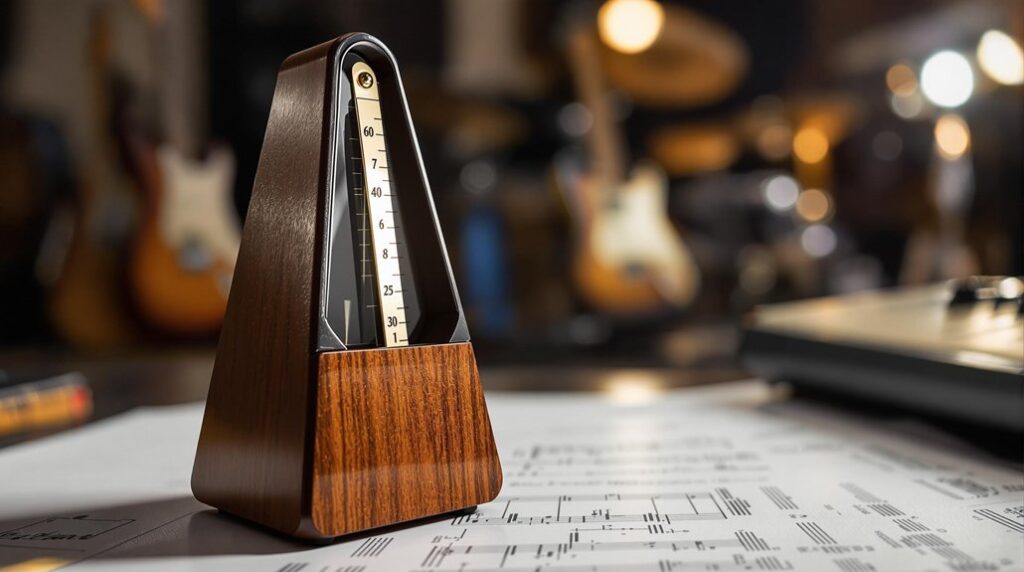As a beginner, you should explore the fundamental concepts of harmony, including intervals, chords, and progressions. Start by understanding how major and minor chords create emotional tension and resolution in your music. Familiarize yourself with essential progressions like I-IV-V; they’ll help shape musical mood and enhance your compositions. Key signatures guide your tonal center, while chord functions clarify each chord’s role. Don’t forget to analyze different genres; each has unique harmonic structures. By grasping these elements, you’ll gain the ability to express emotions through music. There’s much more to discover, which will help enrich your musical journey.
Key Takeaways
- Understand the basic concepts of harmony, including major and minor chords, to enrich melodies and create emotional depth.
- Familiarize yourself with essential chord progressions like I-IV-V to shape mood and emotional impact in your music.
- Explore the emotional character of intervals, as they play a crucial role in shaping harmonic structures and melodies.
- Learn about key signatures to identify tonal centers and enhance expressive capabilities in different musical contexts.
- Analyze harmonic structures across genres to appreciate their unique uses and improve your own musical composition skills.
Fundamental Concepts of Harmony
Harmony serves as the backbone of musical expression, enriching melodies by layering notes that evoke emotional tension and resolution.
At its core, harmony relies on chords, which are built from alternate scale degrees. Understanding major and minor chords is essential, as consonant chords provide stability while dissonant ones introduce tension.
The tonic chord serves as your foundation, offering security within a harmonic framework. Conversely, the dominant chord creates a dynamic tension that yearns for resolution back to the tonic. Additionally, exploring chord inversions can enhance your understanding of harmony by creating smoother transitions between chords.
Chord Progressions Explained
Chord progressions are the backbone of your musical creations, shaping both the mood and emotional impact of your pieces.
By understanding essential progression types like I-IV-V and the emotional journeys they create, you’ll be better equipped to analyze and craft your own music.
Let’s explore how these common progressions function and influence the listener’s experience. Additionally, familiarity with chord progression construction allows you to establish grooves and enhance the musical impact of your compositions.
Essential Progression Types
When you immerse yourself in the world of music, understanding crucial chord progressions can greatly enhance your songwriting and composition skills. Familiarity with common chord progressions like I-IV-V and I-vi-IV-V forms the backbone of many popular songs, bringing a sense of familiarity and emotional depth.
The ii-V-I progression is fundamental in jazz, offering smooth shifts that highlight harmonic complexity. In contrast, progressions like I-iii-IV-V introduce minor chords, enriching the piece’s emotional impact.
If you explore minor key progressions such as i-iv-V or i-VI-VII-i, you can convey darker themes that invite introspection. Mastering these essential progression types allows you to tap into functional harmony, fostering creativity and expanding your musical exploration.
Emotional Impact of Progressions
Understanding chord progressions isn’t just about structure; it’s about the emotions they evoke. Major and minor chords shape the emotional terrain, with major chords often conveying happiness and minor chords inducing introspection.
For instance, the I-IV-V progression provides a strong resolution to the tonic, creating familiarity and emotional resonance. In jazz, progressions like ii-V-I introduce tension before resolving, highlighting the genre’s expressive depth.
By familiarizing yourself with common progressions like I-vi-IV-V, you can tap into established emotional responses, crafting melodies that engage listeners.
Furthermore, variations in rhythm and dynamics can enhance the emotional impact of your harmonic structures, allowing you to manipulate feelings effectively across different musical genres.
Embrace these tools to deepen your compositional skills.
Analyzing Common Progressions
Analyzing common chord progressions reveals the building blocks of countless songs, allowing you to grasp how different combinations create emotional environments.
For instance, the I-IV-V progression forms a stable foundation, while the I-V-vi-IV progression, as heard in “Let It Be,” balances tension and resolution, making it emotionally resonant.
In jazz, the ii-V-I progression showcases how dominant chords smoothly shift back to the tonic, enhancing the narrative flow.
Furthermore, minor key progressions like i-IV-V explore deeper emotions, as exemplified by “Hotel California.”
Understanding chord functions—tonic, dominant, and subdominant—enables you to recognize how these common progressions contribute to the overall mood and structure of a piece, ultimately helping you create harmony in your own music.
Understanding Key Signatures
Key signatures are essential for identifying the tonal center of a piece, guiding you through the sharps or flats you’ll encounter.
By mastering key signature identification, you gain the ability to recognize emotional nuances in music, enhancing your expressive capabilities.
Understanding these signatures not only simplifies your playing but also opens doors to improvisation and composition.
Importance of Key Signatures
While many may overlook their significance, key signatures play an essential role in shaping the harmonic environment of a musical piece. They indicate the scale used, determining which notes are sharp or flat, and directly influence the harmonic structure.
Understanding key signatures helps you anticipate the harmonic scenery, whether you’re in major keys, which create a brighter sound, or minor scales that evoke a darker tone. This knowledge not only enhances your emotional expression but also establishes a tonal center that guides your performance.
Furthermore, mastering key signatures improves communication among musicians, allowing for seamless collaboration without the need for verbal instructions. By embracing key signatures, you’ll enhance your musical experience and connection with others.
Key Signature Identification
Understanding how to identify key signatures is a foundational skill for any musician. Key signatures indicate the tonal center and define which notes will be sharp or flat throughout a piece. Each major key has a corresponding minor key, facilitating harmonic movement. Here’s a quick reference to help you with common key signatures:
| Major Key | Minor Key |
|---|---|
| C Major | A Minor |
| G Major | E Minor |
| D Major | B Minor |
| A Major | F# Minor |
| F Major | D Minor |
Recognizing the order of sharps (F#, C#, G#, D#, A#, E#, B#) and flats (B♭, E♭, A♭, D♭, G♭, C♭, F♭) enhances your understanding of scale degrees and common chord progressions, enriching your harmonic structure.
Emotional Impact of Keys
Emotion plays an essential role in music, and the choice of key signature profoundly shapes that emotional experience. Major keys typically evoke joy and brightness, while minor keys often convey sadness and introspection. Understanding these emotional characters helps you navigate chord progressions effectively.
Each major key has a relative minor key, enhancing harmonic structures and providing depth in emotional expression. By mastering key signatures, you can better anticipate harmonic movements, making your performances and compositions more compelling.
Moreover, modulation techniques allow you to shift smoothly between keys, exploring varied emotional settings. Engaging in harmonic analysis of different key signatures reveals how they influence the overall mood, empowering you to convey specific emotions with greater precision.
The Role of Intervals
Intervals serve as the foundational elements of harmonic structures, defining the distance between two notes and shaping the essence of music. For beginners, understanding intervals is essential for effective chord construction and recognizing harmonic relationships.
Each interval carries an emotional character; for instance, the Major Third (M3) conveys brightness, while the Minor Second (m2) creates tension. By analyzing popular songs, you can see how composers strategically use these intervals to enhance storytelling and engage listeners.
Familiarizing yourself with common intervals not only aids in recognizing chords but also enriches your musical expression. As you explore intervals, you’ll reveal the emotional depth of music, allowing you to convey feelings more powerfully in your own compositions. Additionally, understanding chord progressions helps in crafting compelling harmonic narratives that resonate with your audience.
Exploring Chord Functions
Building on your grasp of intervals, exploring chord functions reveals how chords interact within a key. Each chord plays a distinct role: the tonic (I) provides stability, the dominant (V) creates tension, and the subdominant (IV) offers movement away from the tonic. Understanding these functions is essential for beginners, especially when recognizing the I-IV-V progression, a staple in many genres. This progression enhances harmonic movement and emotional impact. Mastery of these functions can significantly improve your creative experimentation in music.
| Chord Function | Role in Progression | Emotional Impact |
|---|---|---|
| Tonic (I) | Stability | Resolution |
| Dominant (V) | Tension | Anticipation |
| Subdominant (IV) | Movement | Enrichment |
Mastering chord functions will greatly enhance your improvisation and composition skills.
Application Across Musical Genres
As you immerse yourself in the world of music, you’ll find that different genres apply harmonic structures in unique ways, shaping their distinct sounds and emotional expressions.
For instance, jazz often showcases complex chord progressions and extended harmonies, while pop music relies on catchy, repetitive sequences for broad appeal.
In classical music, structured progressions enhance emotional depth, and rock and roll favors familiar I-IV-V progressions to create resonance.
Doo-wop styles evoke nostalgia with I-vi-IV-V sequences.
Electronic music pushes boundaries through synthetic harmonies and scale experimentation. Understanding chord progressions can greatly enhance your ability to create engaging compositions across these genres.
Harmonic Analysis Techniques
Understanding harmonic analysis techniques is essential for uncovering the intricate layers of music. By examining chord progressions and their roles, you can better appreciate how major and minor chords interact within a composition.
Here’s what to focus on:
- Familiarize yourself with Roman numeral chord symbols (I, ii, iii, etc.)
- Analyze cadences, including authentic and deceptive types
- Differentiate between diatonic and non-diatonic chords
- Explore functional harmony to grasp chord functions
- Connect emotionally by studying specific pieces and their harmonic relationships
These techniques will deepen your understanding of how harmonies create tension, resolution, and emotional connections in music.
As you practice, you’ll reveal the complex structures that give each piece its unique character.
Emotional Impact of Harmony
Harmony plays a pivotal role in shaping emotional responses within music, acting as the backbone of a composition’s expressive power. Consonant chords, like major triads, provide stability and evoke happiness, while minor triads introduce a sense of sadness.
By exploring harmonic progressions, you can create tension and resolution, fundamental in crafting emotional settings. For example, dominant chords resolving to tonic chords deliver satisfying emotional releases. The emotional weight of specific intervals—such as the minor third—can evoke longing, while the major third brightens the mood.
Different genres manipulate harmony uniquely; jazz uses complex structures for sophistication, while pop relies on catchy progressions to foster nostalgia. Understanding these dynamics deepens your engagement with music’s emotional impact. Additionally, mastering basic chords enhances your ability to evoke specific feelings through harmonic choices.
Resources for Further Learning
- YouTube tutorials: Explore free lessons on music theory fundamentals.
- Interactive software: Use apps like musictheory.net for exercises on chords and progressions.
- Books: Read “Tonal Harmony” by Stefan Kostka and Dorothy Payne for in-depth concepts.
- Educational websites: Access free guides and worksheets to practice key signatures.
- Local music groups: Join forums or communities to share resources and collaborate with fellow beginners.
- Music production blogs: Follow expert insights on mixing techniques to enhance your harmonic understanding.
Utilizing these resources will solidify your understanding of harmonic structures and foster your growth in music theory.
Happy learning!
Frequently Asked Questions
How Do You Describe a Harmonic Structure?
A harmonic structure’s described through chord progressions, tonal centers, and interval relationships. You analyze scale degrees, voice leading, and harmonic rhythm, focusing on functional harmony and modulation techniques to understand the music’s emotional depth and movement.
What Is a Harmonic Analysis in Music Theory?
Harmonic analysis in music theory helps you understand harmonic functions, chord progressions, and tonal centers. It explores diatonic harmony, modal interchange, voice leading, and harmonic rhythm, revealing how tension and resolution shape musical narratives.
Conclusion
In exploring harmonic structures, you’re revealing the foundation of music itself. By grasping fundamental concepts, chord progressions, and key signatures, you’ll deepen your understanding of how music communicates emotions. As you analyze intervals and chord functions across genres, you’ll enhance your creativity and expressiveness. Don’t forget the resources available to further your journey. Embrace this exploration—each discovery will enrich your musicality and inspire your compositions. Happy harmonizing!




